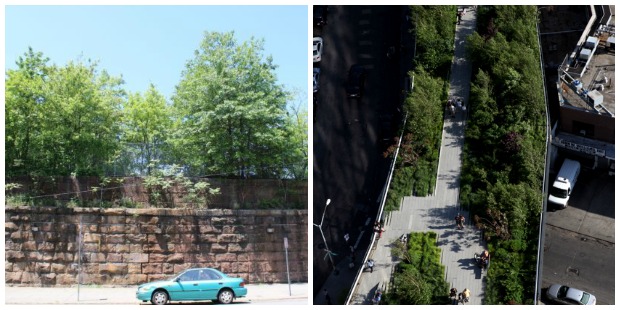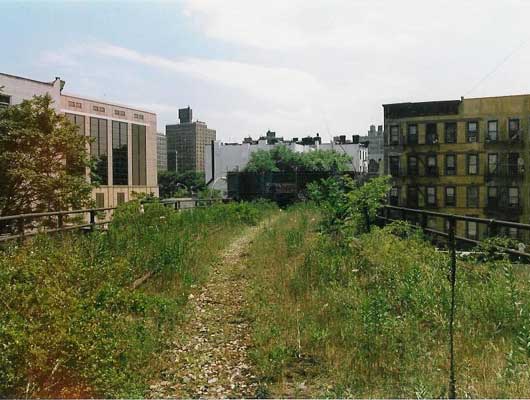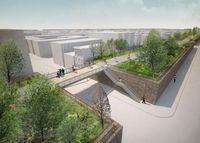More Reason to Visit Jersey!
Using the High Line as a Model, Jersey City Bets on the Embankment
Friday, June 08, 2012
Play
04:41 / 04:41
At the intersection of Jersey Avenue and 6th Street, in downtown Jersey City, stands an imposing structure of stone and granite that towers over a Brownstone-lined street. Ivy cascades down the sides, while 20- and 30-foot-tall trees grow on top. Huge reddish brown boulders pile up for two stories, with tiny fern-like plants breaking out of the crevices. It’s Stephen Gucciardo’s favorite section of the Embankment, a six-block, half mile-long spur of the Pennsylvania Railroad.
“Without any of us having touched the Embankment, it’s already a park,” Gucciardo said.
He is the president of the Embankment Preservation Coalition, a group that has fought to preserve the rail spur that slices through the historic Harsimus Cove neighborhood. The tracks haven’t been used since the early 1990s.
“The stones are beautiful, the color is delicious. They beautifully fit together, and the top is perfectly level,” Gucciardo said. “You’re looking at master craftsmanship here that was hard to come by and expensive at the turn of the century when this was built.”
Jersey City residents and government officials are closer than ever to concluding a 13-year battle to acquire the Embankment and turn it into an open space at the center of this urban neighborhood. The process has been saddled by a series of lawsuits involving the city, private developer Steve Hyman and railroad company Conrail, over who has the right to own the property. The issue hinges on arcane federal railroad law over whether Conrail’s sale of the property to Hyman in 2003 for $3 million was legal. So far, the city has spent $500,000 in legal fees, according to corporation counsel Bill Matsikoudis.
But a settlement authorized by the City Council in February may finally move the process forward — if Conrail and Hyman sign on. Under the terms of the settlement, Hyman would get $20 million, Conrail would get development rights on one block of the Embankment, and the city would pay $7 million for the remaining five blocks to build a park and mass transit corridor. The Council voted unanimously to authorize the settlement in February.

(Photo: Stephen Gucciardo and others hope the Embankment, left, can be preserved like the High Line, right.)
The city wasn’t always so supportive of the project. The price tag for the acquisition, legal fees, clean up, planning and building could cost upwards of $50 million dollars, Mayor Jerramiah Healy explained. He admits it took some convincing to get him on board, but was ultimately won over by the possibility of extending the New Jersey Transit Light Rail along the Embankment, from the Hudson River waterfront all the way to Secaucus.
“You know, we’re always concerned about the bottom line here in Jersey City and you can’t hit the tax payers over the head all the time, so that was a concern,” Healy stressed.
But the success of the High Line across the Hudson has also shown officials what could be possible in Jersey City.
“I would say we get a call almost every week from somebody doing a similar kind of project,” said Robert Hammond, the co-founder and executive director of Friends of the High Line. “They’re not all elevated rail lines, but they’re just community-initiated projects of reclaiming industrial space and trying use them in different ways.”
Hammond serves on the advisory council for the Embankment, and one piece of advice he passed on is remembering that the High Line wasn’t always what it is today.
 “In the beginning almost all the main groups were opposed to it,” Hammond recalled. “To some people they just thought it was a relic and wasn’t attractive, and would look better torn down. To others, there was a lot of people that [said], ‘Oh it’s a great idea but it’s never going to happen.’”
“In the beginning almost all the main groups were opposed to it,” Hammond recalled. “To some people they just thought it was a relic and wasn’t attractive, and would look better torn down. To others, there was a lot of people that [said], ‘Oh it’s a great idea but it’s never going to happen.’”
(Photo: The High Line before its transformation./Courtesy of The Friends of the High Line)
Now the High Line is one of New York City’s most popular attractions, drawing more than 7 million visitors since the first section opened in 2009. That was the same year, Hammond toured Jersey City’s Embankment, and was impressed by what he saw.
Hammond thinks the “Embankment has a whole other feel to it” than the High Line.
“It feels more natural in some ways because of these stone walls. And then what’s growing up there is so much more robust and stronger than anything that was ever growing up on the High Line. In the Embankment, you really feel like you have a forest in the middle of Jersey City,” he explained.
Jersey City Councilman Steven Fulop, whose district encompasses the Embankment, is optimistic that the project will follow in the High Line’s footsteps. “We think we have an opportunity here to create something at least as powerful, if not better,” Fulop said.
If all three parties agree on the legal settlement, the city could acquire the land in as few as six months. But if the other litigants don’t agree to the terms, another court battle could set the project back five or six more years. With the neighborhood around New York’s High Line booming, city officials are more motivated than ever to see the project through to the finish.
And that excites residents in the neighborhood. Dolores Rennar has lived on 6th Street facing the Embankment for all of her 68 years, and fondly remembers the railroad where her grandfather worked.
“I loved it,” Rennar said. “The kids used to write their names on the wall, and climb it to get coal.”
“I don’t care what they turn it into,” Rennar added, referring to the plans for the Embankment, “as long as they don’t take it down.”
